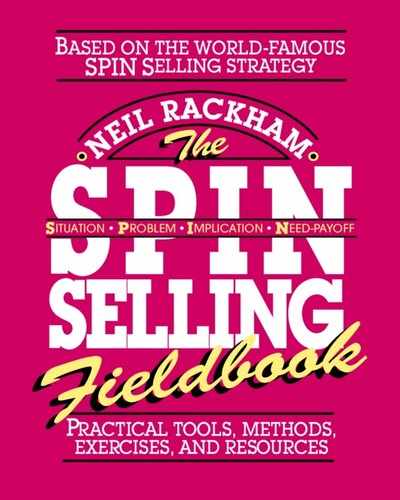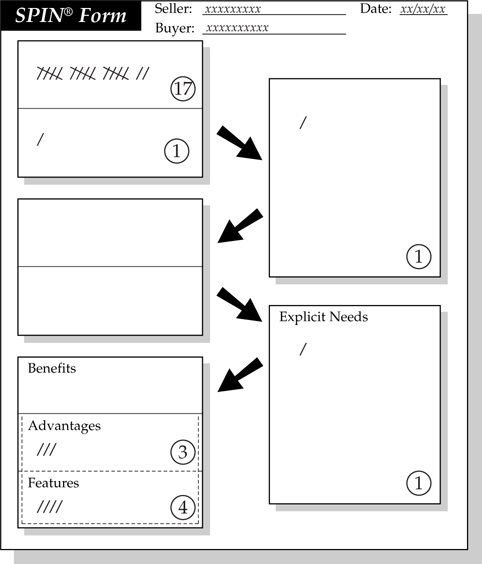12
Sharpening Your Skills
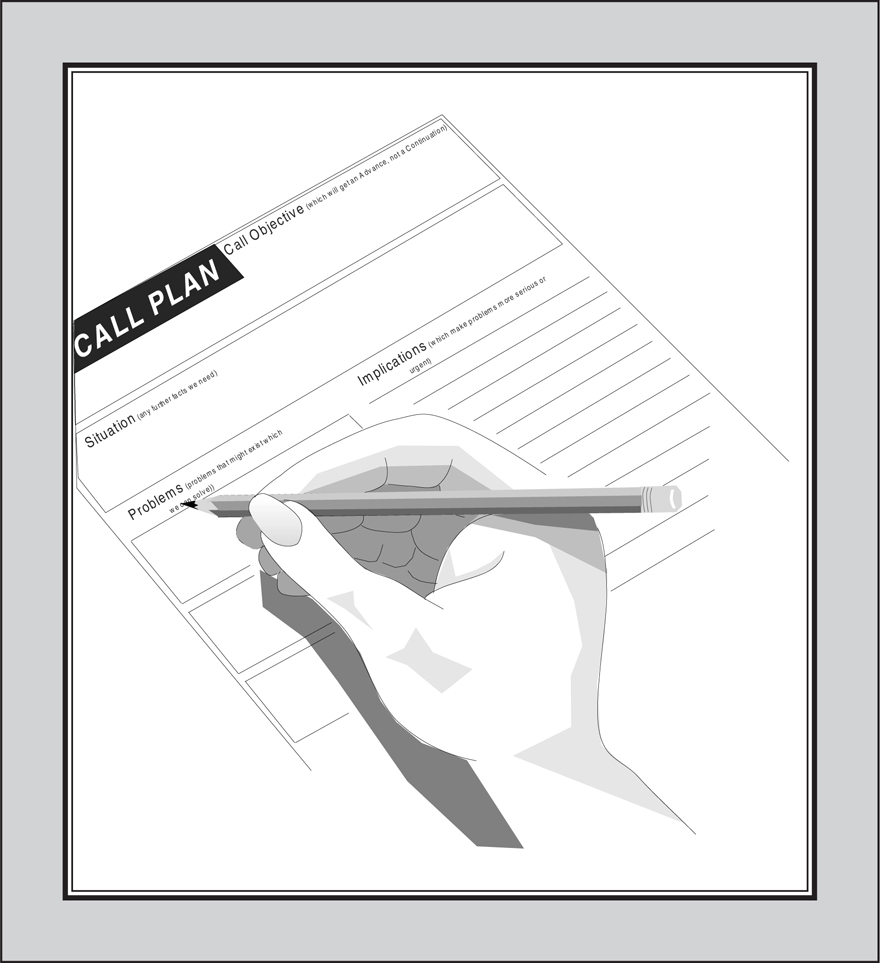
What to Expect
What bottom-line improvement should you expect from developing your SPIN® skills? The first thousand people we trained in these skills averaged a 17 percent increase in their sales results. Will that happen for you? Many people have more than doubled their sales volume after learning and practicing the skills and techniques we’ve described in this Fieldbook. But a little application of simple mathematics should warn you that, based on an average increase of 17 percent, if some have more than doubled their sales, there must also be some who were below average or who didn’t benefit at all. How do you make sure that you’re in the group that gets above-average results?
The bad news is that there’s no magic formula to give you a cast-iron guarantee of better sales results. But the good news is that we have strong evidence showing that, if you get just three things right, there’s a very high probability that you will achieve superior results from these methods. None of these three things is particularly difficult, though each requires hard work, persistence, or a shift in perspective. They are:
![]() Get on the buyer’s side of the table.
Get on the buyer’s side of the table.
![]() Invest in planning.
Invest in planning.
![]() Give yourself a periodic checkup.
Give yourself a periodic checkup.
Let’s look at each one in detail.
Get on the Buyer’s Side of the Table
One of the hardest shifts for many traditional salespeople is to change their thinking so that they stop acting like a seller and, instead, see the world from the buyer’s perspective. When we talk about getting on the buyer’s side of the table, we don’t mean trying to manipulate the buyer by pretending to see things from the buyer’s point of view.
What we are talking about is a fundamental shift in perspective. You have to abandon the old mentality of seller vs. buyer. In its place you must genuinely share the buyer’s concerns. Specifically, it means that you must shift your thinking in two respects:
![]() Shift from persuading to understanding.
Shift from persuading to understanding.
![]() Shift from a product focus to a buyer focus.
Shift from a product focus to a buyer focus.
Shift from Persuading to Understanding
Traditionally, most salespeople see their primary function as persuading. This leads them to argue the merits of their products, and to become advocates for their companies and for the services they offer. What’s wrong with persuasion or advocacy? Simply, it’s not the perspective that the world’s most successful salespeople take.
From working with many hundreds of top salespeople in fields as diverse as consulting and chemicals, we find that the primary perspective of top salespeople is understanding rather than persuading. They see their first and foremost responsibility as understanding the world from the buyer’s point of view. This perspective has a dramatic impact on how they sell. Because they really care about what their buyers think, they ask more questions than traditional salespeople. They are less inclined to talk prematurely about products and solutions. And, because they are sincerely trying to understand their buyers’ issues, this communicates to their buyers and they are seen as genuine.
What does this have to do with improving your SPIN® skills? A whole lot. If you set out to understand, then you are more likely to ask questions, less likely to give Features and Advantages and less likely to jump in too soon with solutions. Also, research suggests that you’ll listen better and be more likely to hear the buyer’s real needs.
A nice illustration of how true this is in practice comes from one of the world’s largest telecommunications companies. Their sales force was asked to go to a sample of their existing customers and conduct a survey to understand what these customers were doing, how their environment was changing, and what issues they were facing. The consultants who had designed the survey emphasized that, in order to provide objective data, the sales force should just try to understand these customers better and on no account should use the survey calls to sell.
In the three months that followed, to the combined amazement of the consultants, the company’s management, and the sales force, there was a 35 percent increase in sales to the customers involved in the survey compared with all other customers. The reason was simple. Because the survey forced the sales force to really focus on understanding their customers, they uncovered new needs and saw additional productive opportunities. Even better, customers responded very positively to being understood and invited salespeople back to do more business.
So take a tip from top salespeople. An easy way to improve both your skills and your sales is to see each call as an opportunity to understand rather than to persuade.
Shift from a Product Focus to a Buyer Focus
One metaphor for the role of salespeople is that they are a bridge between products and customers. The seller is the connector, the link that brings buyers and products together. The effective salesperson has to understand both ends of this bridge—to understand on the one side buyers and their needs and on the other side the capabilities of products and services. Which end of this bridge is more important for sales success? The evidence seems to show that:
![]() Most salespeople are more comfortable and proficient at understanding their products than at understanding their buyers.
Most salespeople are more comfortable and proficient at understanding their products than at understanding their buyers.
![]() Very successful salespeople have adequate product knowledge, but superior knowledge of customers.
Very successful salespeople have adequate product knowledge, but superior knowledge of customers.
![]() Salespeople with the highest product knowledge don’t make the most sales.
Salespeople with the highest product knowledge don’t make the most sales.
![]() If forced to make a choice, buyers are more likely to deal with those who best understand their needs than with those who best understand products or services.
If forced to make a choice, buyers are more likely to deal with those who best understand their needs than with those who best understand products or services.
So, if you are a typical salesperson, there’s a good chance that right now you are putting too much emphasis on the products and services side of the bridge. Shifting your attention to understanding buyers will probably pay off for you in terms of results.
That means things like:
![]() Keeping up with business and industry trends that affect your buyers.
Keeping up with business and industry trends that affect your buyers.
![]() Reading current business journals rather than product manuals.
Reading current business journals rather than product manuals.
![]() Having a real curiosity about what’s going on inside the buyer’s organization and asking lots of questions about changes that have an impact on the buyer’s operation.
Having a real curiosity about what’s going on inside the buyer’s organization and asking lots of questions about changes that have an impact on the buyer’s operation.
A relentless interest in the buyer’s business issues has paid off for those who have behaved this way. We once did a study for IBM to find why some salespeople learned how to sell much more quickly than others. We found that on the whole those with the greatest knowledge of computers had only average learning curves.
The fastest learners—who became the future high fliers of IBM—were the ones whose focus on their buyers made them curious about business issues. Even without training, these fast learners naturally asked SPIN® questions because they were really interested in their buyers’ problems and the implications behind these problems. In consequence, every call that they made gave them an opportunity to learn through their questions about business issues, industry trends, and areas of importance to customers.
In contrast, those with the highest product knowledge were more likely to spend time in calls talking about IBM and its capabilities. They learned much less about their buyers and their results were poorer as a consequence. So one way to improve both your selling and your SPIN® skills is to be sure you shift from a product focus to a buyer focus.
Invest in Planning
You don’t build a house or a factory by starting it and then figuring out what you should be doing as you go along. In fact, there’s hardly any complex enterprise that you can complete successfully just by winging it. Successful execution always rests on successful planning. It wouldn’t be necessary to say this about most other professions. Unfortunately, selling stands out as one of the few areas where planning is undervalued or even absent. We are continually amazed at how many salespeople don’t plan calls.

Notice that we say “salespeople don’t plan calls.” Many large account salespeople write elaborate plans for each major account. In fact, account planning takes up a good deal of time in most high-end sales forces.
But, to succeed in achieving your major account plan you must successfully execute a number of opportunities. We define an opportunity as a series of sales calls that could culminate in a major sale. Much less time is spent planning opportunities than planning accounts. Yet, unless the component opportunities succeed, the account plan will fail.
Plan Your Calls
But let’s move down one level of detail. Each opportunity is made up of a number of calls and each call must be successful for the opportunity to be met. So individual sales calls are the building blocks out of which opportunities are constructed, and a series of opportunities must be achieved in order to successfully execute an account plan. Our concern is that few salespeople pay enough attention to planning the humble sales calls that are the fundamental units making up account success.
If there was just one piece of advice we could give people to improve their selling, it would be this: Plan your calls. Worry less about grand strategy and more about the tactics of each call. Think of an actual sales call you are planning to make in the near future. How clear are you about the objective of the call? Do you know exactly what outcome you hope to achieve? What specific questions do you plan to ask? What planning tools are you using to help you to prepare? If you don’t have good answers to these questions, you probably don’t have an adequate call plan. Call planning is the bedrock on which sales strategy is built.
Time and time again in our work we’ve seen elegant account strategies fail because the call execution skills just weren’t there. We’re not saying that strategy is unimportant. Our book, Major Account Sales Strategy (McGraw-Hill, 1989), gives clear evidence that overall account strategy is crucial to success in major accounts. The problem that we’ve seen over the years is that no strategy is better than the capacity to execute it and—on an individual call level—execution more often than not lets the strategy down. So what advice would we give you to help your call planning? Three points:
1. First, plan Advances.
2. Then plan what to ask, not what to tell.
3. Use a planning tool to help you prepare.
Take a call you’ll be making in the near future and try this advice out for yourself.
1. First, Plan Advances
In Chapter 4 we talked about call outcomes and the importance of Advances. We explained the distinction between Advances and Continuations.
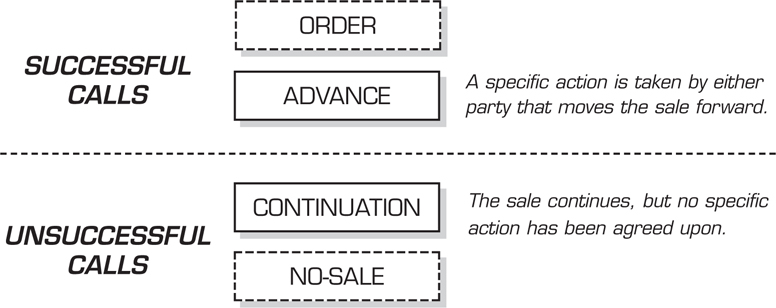
Simple though this distinction is, it’s vitally important to successful planning and, even more important, it’s vital to successful selling. One of the differences between top salespeople and their less successful colleagues is that top performers are very clear about the Advances that are possible from each call and they set call objectives based on the highest realistic Advance they can achieve.
Let’s try this out with a call you intend to make.
![]() First brainstorm at least five possible Advances you could make from the call.
First brainstorm at least five possible Advances you could make from the call.
![]() Check that each Advance you have listed is an action that is realistic and that really moves the sale forward.
Check that each Advance you have listed is an action that is realistic and that really moves the sale forward.
![]() Choose the best of these Advances as your Call Objective. The best Advance is the one that most moves the sale forward while being realistic and achievable.
Choose the best of these Advances as your Call Objective. The best Advance is the one that most moves the sale forward while being realistic and achievable.
Finally, choose a fallback objective—a less ambitious Advance that still moves the sale forward but will be easier to achieve if your first Advance proves unobtainable.
Example
Call: New material call on Jeff Love, Buyer at Metco
Now try planning Advances for your own call:
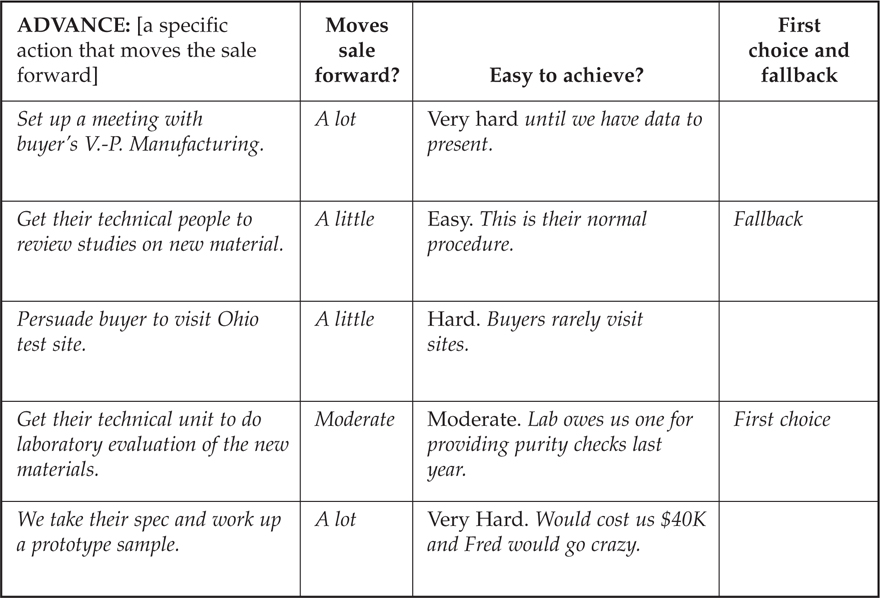
Call: _____________________________________________________
One of the characteristics of very successful salespeople is their ability to think of a wide range of ingenious Advances. Less successful salespeople often find it difficult to think beyond the most obvious ways to move the sale forward. Use this exercise to stretch your thinking and to generate as wide a range of Advances as possible. We’ve asked here for five, but if you can think of ten, so much the better.

2. Plan What to Ask, Not What to Tell
Once you’ve selected your first choice Advance and your fallback, what do you do next? You plan the call itself. It’s here that we sometimes play a nasty little trick on salespeople we’re working with. Before we discuss planning, and without any warning, we ask them to take a piece of paper and jot down a quick plan for a sales call they intend to make within the next week.
We then ask them the all-important question: “Did you plan what you were going to tell or what you were going to ask?” Almost 80 percent of our victims have planned what they are going to tell. The 20 percent who have planned what they intend to ask are generally the most experienced and successful members of the group.
If you’d been in one of these groups, what would you have done? Be honest: Would you really have been in the 20 percent who planned questions?
If, like most people, you plan what you intend to tell, then no wonder it’s hard to ask effective questions while you’re selling. Remember:
![]() Plan it, or you just won’t do it.
Plan it, or you just won’t do it.
![]() If you want to get on the buyer’s side of the table, you must shift from persuading to understanding. Asking questions is the best way to understand your buyer.
If you want to get on the buyer’s side of the table, you must shift from persuading to understanding. Asking questions is the best way to understand your buyer.
The secret to asking effective questions lies in planning them. One way to do this is just to write down a list of questions. That’s how many successful salespeople plan. However, an even better way is to use a planning tool.
3. Use a Planning Tool

How to Use the SPIN® Call Plan Form
The SPIN® Call Plan form is a simple and intuitive way to plan sales calls. We’ve evolved and tested it with thousands of salespeople. There are copies at the end of the book for you to use in planning other calls. Here are some points to help you get the most from it.
1. Advances
It’s hard to plan good questions if you don’t know where you want the call to go. So always start by planning an Advance that moves the sale forward. Remember that you usually have a choice of Advances. Choose the one that gives you the best combination of forward movement with ease of achievement. The more ambitious your Advance is in terms of forward movement, the more important it is to also plan a fallback objective for the call in case your first Advance proves unachievable.
2. Situation Questions
Plan only essential Situation Questions that give you information you can’t find from other sources. We advise people to plan Situation Questions last. That way they put most of their energy into planning more powerful questions. It’s easy to come up with a long list of Situation Questions that you would like to ask, but doing so won’t help you sell. The skill of planning Situation Questions lies in reducing your list. Ask yourself whether a Situation Question you would like to ask is really essential. If not, particularly if you are selling to a senior executive, it’s better to leave it out.
3. Problem Questions
Plan to uncover at least three problems that you can solve with your products or services. By planning a variety of problems, you’ll have the flexibility to move to a new problem area if the one you first explore turns out to be unproductive. You’ll find it easier to plan Problem Questions if you start by identifying the problem areas you intend to explore and only think of the questions after you have chosen the areas. So, for example, you might first decide that this buyer has problems in the areas of reliability and speed. Once you’ve chosen these areas, you might plan questions such as, “Do you find your present system too slow?” or “How many failures are you getting?”
These are the hardest questions to plan but the ones where planning has the greatest rewards. A single good Implication Question can make the sale. As with Problem Questions, you should identify implication areas first and then frame your Implication Questions. You don’t need many Implication Questions to create impact. A couple of good questions for each problem area will usually be enough.
5. Explicit Needs and Benefits
Remember that a Benefit always meets an Explicit Need. So when you plan the Benefits you hope to offer, each one first depends on developing an Explicit Need. It’s good discipline to plan Explicit Needs and Benefits together because, without Explicit Needs, there will be no Benefits.
Get into the habit of using a call planning tool like this one. Remember that you can’t have an effective sales strategy without good calls. Planning is worth the effort. There’s no other single thing you can do to improve your selling that compares with systematic call planning. Make it a way of life and see how your results improve.
Give Yourself a Periodic Checkup
We are all creatures of habit. Even if we have the right skills, even if we know the correct way, bad habits creep in. We get lazy; we take shortcuts. Imperceptibly, without ever reaching conscious awareness, we develop habit patterns that hurt our selling. Let me give you a personal example.
When I first discovered the SPIN® model, I realized that I needed to improve my own selling. I was doing too much telling. I was jumping in with solutions too quickly. Most of my questions were Situation Questions. In short, the discoverer of the SPIN® model was lousy at selling. But I was determined to change and to take my own medicine. Through lots of practice and through careful planning of my sales calls I slowly improved until—though I say so myself—I was pretty good at it. Even better, my results improved dramatically and I brought in some big orders for Huthwaite, my consulting firm. I thought I was all set for a dynamite career in sales.
Then, with the success of SPIN® Selling, I had the misfortune to become well known.
I was invited to make speeches all over the world, including such exotic places as Cleveland, Ohio. I was on the guru circuit. I talked, I spoke, I expounded. In other words, I was doing a lot of telling and not much seeking. But—and here’s the point of the story—I didn’t realize that bad habits were creeping up on me. In my own mind I was still the same old lovable SPIN® seller who had questioned his way to success.
One day a client asked me to participate in a television documentary about the SPIN® model. They wanted to film me making a sales call to serve as an example for their salespeople. I agreed and so we set up a call and arrived at the buyer’s office complete with video crew. Afterwards, as I watched the tapes, I realized that what I had intended as a shining example was actually a dreadful warning. I counted the questions I had asked. There was a total of seven—and six of them were low-powered Situation Questions. To my horror, I saw that in the months on the guru circuit I had returned to some of my bad habits. I was telling my way through the SPIN® model. Instead of asking Problem Questions, I was telling the buyer about problems. I was explaining implications, not asking about them. It was a disgraceful exhibition and I was thoroughly ashamed of myself.
Since then, I’ve given myself a checkup from time to time to keep myself honest. I advise you to do the same. I take a small tape recorder into the call with me. With the buyer’s permission, I tape the call and analyze it afterwards. These checkups help me see when I’m slipping back into bad habits. They also highlight areas where I need to improve and they help sharpen my skills. I’ve learned a lot from analyzing my own selling.
The next page shows the tool I use to help myself.
This example is from one of my own checkup calls. I asked the buyer if I could tape record the call. Don’t be nervous about doing this. Hundreds of salespeople I’ve worked with use the SPIN® checkup tool. They regularly ask buyers for permission to tape calls. They rarely get refusals and, in many cases, buyers have expressed admiration for the professionalism of people who care enough to work at improving their skills.
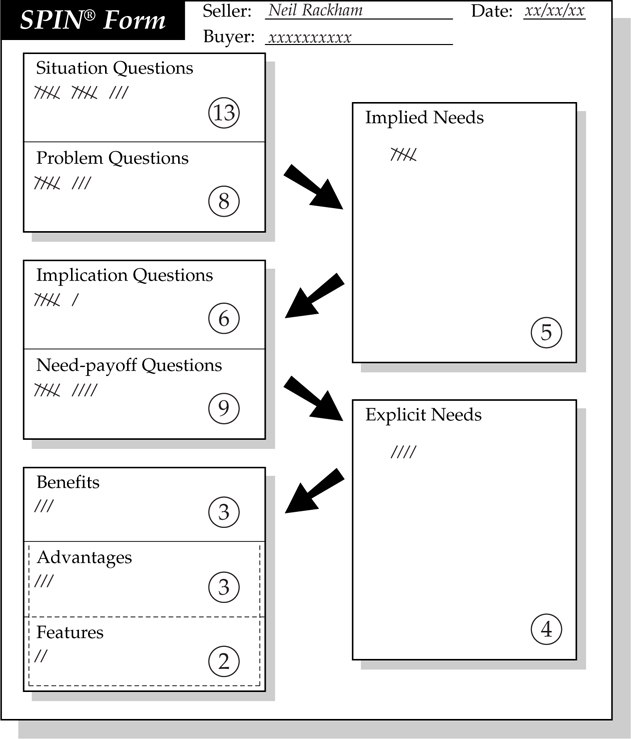
When I got home, before I played the tape, I reread my SPIN® Call Plan to help remind me of what I was trying to achieve in the call and what questions I had planned to ask. I then played the tape once all the way through without stopping. I asked myself these questions:
![]() Did the call go as I had planned? In particular, did I achieve the Advance I had hoped for?
Did the call go as I had planned? In particular, did I achieve the Advance I had hoped for?
![]() Was there anything that went well, that I might want to remember for future calls?
Was there anything that went well, that I might want to remember for future calls?
![]() Was there anything less effective than I would have liked?
Was there anything less effective than I would have liked?
Assessing the Call
Here are my actual notes on the answers to these questions:
As you can see, I had a few surprises. You’ll probably find, as I did, that you hear things on the tape that you missed entirely during the call itself. And, with luck, you’ll find some things worth remembering for future calls.
Finally, I replayed the tape, using the SPIN® Form to analyze my questions. Every time I asked a question, I made a tick mark in the appropriate box. That way I could see the number of questions I asked in the call and how they were distributed across the SPIN® categories. Since I’ve done this a lot, I was able to play the tape without stopping while I analyzed the behaviors used in the call. If you haven’t done this before, stop the tape after each behavior while you decide which type of question you asked, or whether you were describing a Feature, an Advantage, or a Benefit.
On the next page you’ll find a blank SPIN® Form for analyzing one of your calls. You’ll find an additional copy at the end of the book.
Analyze One of Your Own Calls
Use this SPIN® Form to analyze a recording of a call you’ve made. If you don’t have an opportunity to record a real call, role play a call with a friend to give you material for this analysis.
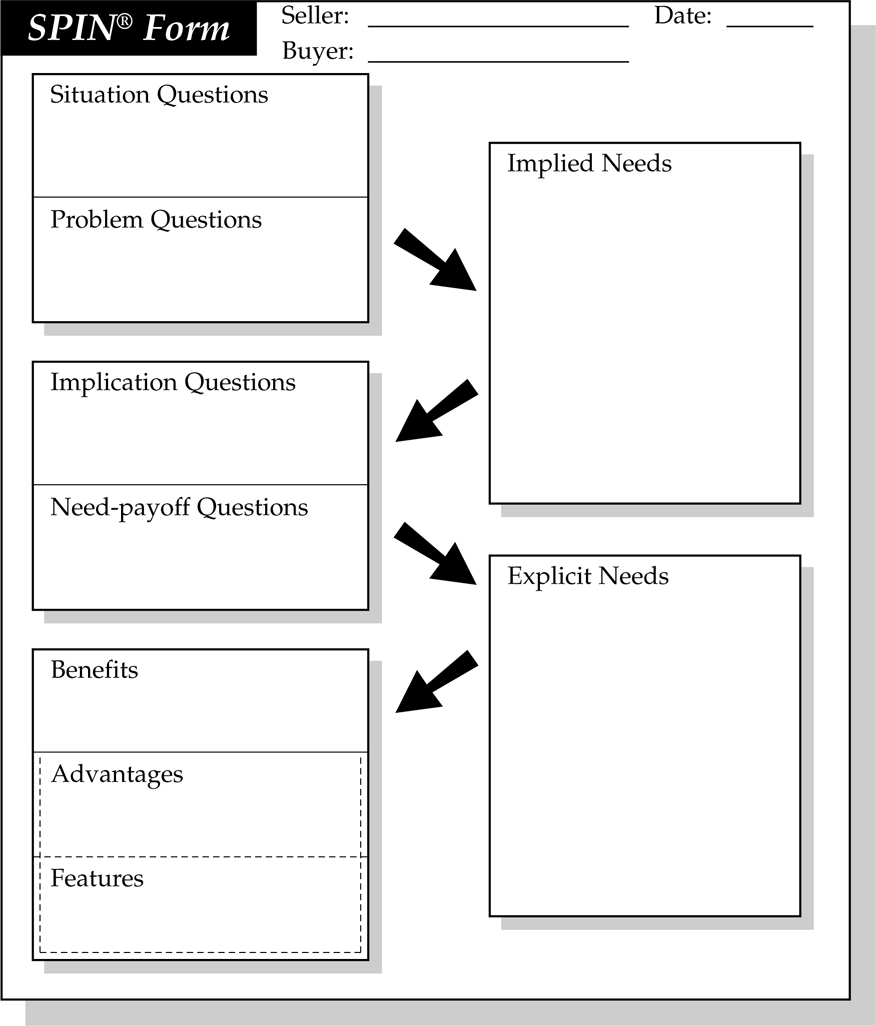
Interpreting Your SPIN® Checkup
What do the numbers from a SPIN® Form mean? In my case, for example, I asked 13 Situation Questions. Is that too few or too many? I asked six Implication Questions. Is that good or bad? The answer is that the precise number matters much less than the overall pattern. I asked more Situation Questions than any other type, but that’s normal. The overall pattern is a good one. I asked about problems [eight Problem Questions] and developed some of those problems with the six Implication Questions and nine Need-payoff Questions I asked.
Where would I like to improve? Two areas could be better. This was a complex call and I think I could usefully have asked even more Implication Questions. Another area that could be improved is Benefits. I gave three Benefits but, listening to the tape, I heard an opportunity for at least one more that I missed.
To help you interpret your own pattern, here are four typical SPIN® profiles:
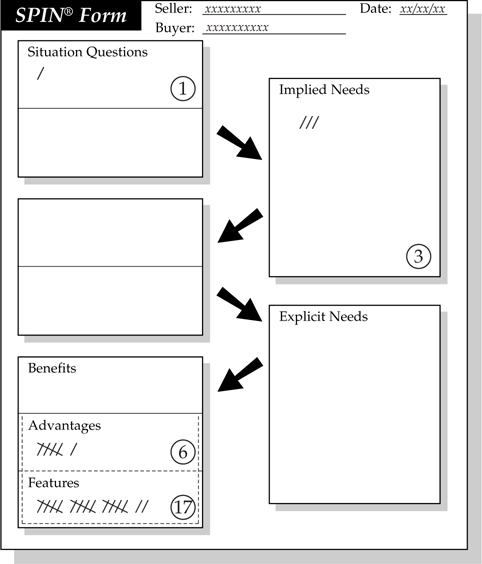
Profile 1: Eddie Expert
This is a typical profile of an overzealous expert. Very few questions—in this case just one. Lots of Features—telling more about the product than the buyer could possibly want to know.
Improvement: Ask questions—any questions.
Profile 2: Just the Facts, Ma’am
This profile is typical of the inexperienced person who feels safe asking for facts. Unfortunately it’s boring to the buyer.
Improvement: Work on planning and asking more Problem Questions, particularly by using the SPIN® Call Plan.
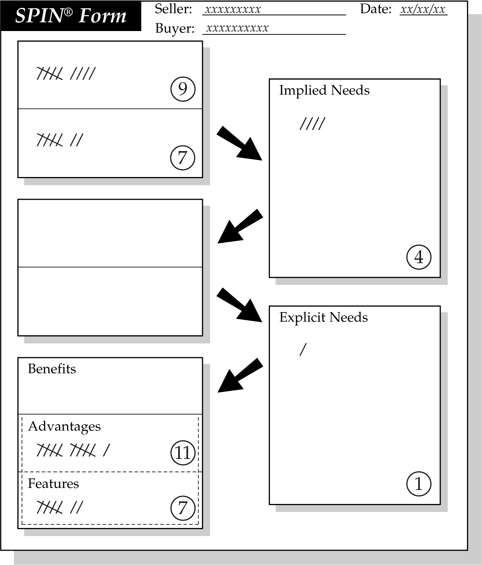
Profile 3: Go for the Jugular
This is the classic profile of the experienced person who can’t resist jumping in too soon with solutions.
Improvement: Hold back from offering answers. Instead, plan and use Implication Questions.
Profile 4: Solution-Short
It’s a rarer profile, but sometimes we see sellers like this one who know how to sell but aren’t comfortable talking about their products. They ask good questions, but don’t know the Features, Advantages, and Benefits of their offering.
Improvement: Work on product knowledge.
Your own pattern may not look exactly like any of these profiles. However, by analyzing your selling in this way, you’ll gain new insights into how well you use questions and you’ll see opportunities to improve your selling.
In this chapter we’ve offered advice and tools for sharpening your selling skills. We’ve suggested that you:
![]() Get on the buyer’s side of the table, by shifting from persuading to understanding and by shifting from a product or service focus to a buyer focus.
Get on the buyer’s side of the table, by shifting from persuading to understanding and by shifting from a product or service focus to a buyer focus.
![]() Invest in planning, using a tool such as the SPIN® Call Plan.
Invest in planning, using a tool such as the SPIN® Call Plan.
![]() Give yourself a periodic checkup, by recording your calls and analyzing them afterwards.
Give yourself a periodic checkup, by recording your calls and analyzing them afterwards.
This approach—and using the Call Plan form and the SPIN® Form—has been field tested by thousands of salespeople. It works. It takes time and effort but, if you could talk with the many people who have used this approach, they would tell you that their investment was worthwhile.
